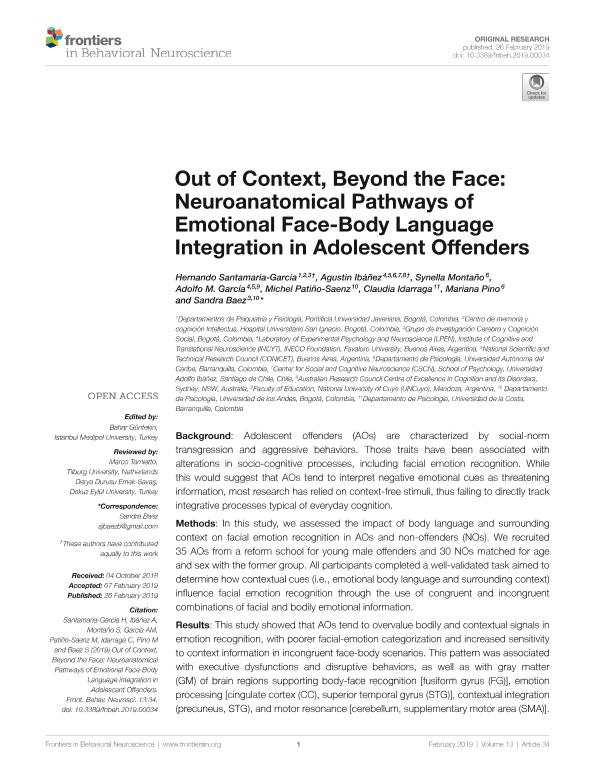Artículo
Out of context, beyond the face: Neuroanatomical pathways of emotional face-body language integration in offender adolescents
Santamaria Garcia, Hernando ; Ibañez, Agustin Mariano
; Ibañez, Agustin Mariano ; Montano, Synella; García, Adolfo Martín
; Montano, Synella; García, Adolfo Martín ; Patiño Sáenz, Michel; Idárraga, Clauida; Pino, Mariana; Báez Buitrago, Sandra Jimena
; Patiño Sáenz, Michel; Idárraga, Clauida; Pino, Mariana; Báez Buitrago, Sandra Jimena
 ; Ibañez, Agustin Mariano
; Ibañez, Agustin Mariano ; Montano, Synella; García, Adolfo Martín
; Montano, Synella; García, Adolfo Martín ; Patiño Sáenz, Michel; Idárraga, Clauida; Pino, Mariana; Báez Buitrago, Sandra Jimena
; Patiño Sáenz, Michel; Idárraga, Clauida; Pino, Mariana; Báez Buitrago, Sandra Jimena
Fecha de publicación:
02/2019
Editorial:
Frontiers Media S.A.
Revista:
Frontiers in Behavioral Neuroscience
ISSN:
1662-5153
e-ISSN:
1662-5153
Idioma:
Inglés
Tipo de recurso:
Artículo publicado
Clasificación temática:
Resumen
Background: Adolescent offenders (AOs) are characterized by social-norm transgression and aggressive behaviors. Those traits have been associated with alterations in socio-cognitive processes, including facial emotion recognition. While this would suggest that AOs tend to interpret negative emotional cues as threatening information, most research has relied on context-free stimuli,thus failing to directly track integrative processes typical of everyday cognition. Methods: In this study, we assessed the impact of body language and surrounding context on facial emotion recognition in AOs and non-offenders (NOs). We recruited 35 AOs from a reform school for young male offenders and 30 NOs matched for age and sex with the former group. All participants completed a well-validated task aimed to determine how contextual cues (i.e., emotional bodylanguage and surrounding context) influence facial emotion recognition through the use of congruent and incongruent combinations of facial and bodily emotional information. Results: This study showed that AOs tend to overvalue bodily and contextual signals in emotion recognition, with poorer facial emotion categorization and increased sensitivity to context information in incongruent face-body scenarios. This pattern was associated with executive dysfunctions and disruptive behaviors, as well as with gray matter of brain regions supportingbody-face recognition (fusiform gyrus), emotion processing (cingulate cortex, superior temporal gyrus), contextual integration (precuneus, superior temporal gyrus), and motor resonance (cerebellum, supplementary motor area). Discussion: Together, our results pave the way for a better understanding of the neurocognitive association between contextual emotion recognition, behavioral regulation, cognitive control, and externalized behaviors in AOs.
Archivos asociados
Licencia
Identificadores
Colecciones
Articulos(INCYT)
Articulos de INSTITUTO DE NEUROCIENCIAS COGNITIVAS Y TRASLACIONAL
Articulos de INSTITUTO DE NEUROCIENCIAS COGNITIVAS Y TRASLACIONAL
Citación
Santamaria Garcia, Hernando; Ibanez Barassi, Agustin Mariano; Montano, Synella; García, Adolfo Martín; Patiño Sáenz, Michel; et al.; Out of context, beyond the face: Neuroanatomical pathways of emotional face-body language integration in offender adolescents; Frontiers Media S.A.; Frontiers in Behavioral Neuroscience; 13; 2-2019; 34-34
Compartir
Altmétricas



